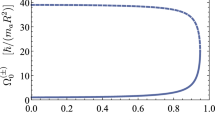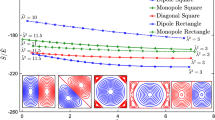Abstract
We study the two-dimensional Ginzburg-Landau model of a neutral superfluid in the vicinity of the vortex unbinding transition. The model is mapped onto an effective interacting vortex gas by a systematic perturbative elimination of all fluctuating degrees of freedom (amplitudeand phase of the order parameter field) except the vortex positions. In the Coulomb gas descriptions derived previously in the literature, thermal amplitude fluctuations were neglected altogether. We argue that if one includes the latter, the vortices still form a two-dimensional Coulomb gas, but the vortex fugacity can be substantially raised. Under the assumption that Minnhagen's generic phase diagram of the two-dimensional Coulomb gas is correct, our results then point to a first-order transition rather than a Kosterlitz-Thouless transition, provided the Ginzburg-Landau correlation length is large enough in units of a microscopic cutoff lenght for fluctuations. The experimental relevance of these results is briefly discussed.
Similar content being viewed by others
References
O. Penrose and L. Onsager,Phys. Rev. 104:576 (1956); C. N. Yang,Rev. Mod. Phys. 34:694 (1962).
N. D. Mermin and H. Wagner,Phys. Rev. Lett. 17:1133 (1966); P. C. Hohenberg,Phys. Rev. 158:383 (1967).
G. Lasher,Phys. Rev. 172:224 (1968).
M. E. Fisher, M. N. Barber, and D. Jasnow,Phys. Rev. A 8:1111 (1973).
D. J. Bishop and J. D. Reppy,Phys. Rev. B 22:5171 (1980).
M. R. Beasley, J. E. Mooij, and T. P. Orlando,Phys. Rev. Lett. 42:1165 (1979).
B. I. Halperin and D. R. Nelson,J. Low Temp. Phys. 36:599 (1979).
A. F. Hebard and A. T. Fiory,Phys. Rev. Lett. 44:291 (1980).
A. F. Hebard and A. T. Fiory,Phys. Rev. Lett. 50:1603 (1983); A. T. Fiory, A. F. Hebard, and W. I. Glaberson,Phys. Rev. B 28:5075 (1983).
C. Leemann, P. Flückiger, V. Marsico, J. L. Gavilano, P. K. Srivastava, P. Lerch, and P. Martinoli,Phys. Rev. Lett. 64:3082 (1990).
S. Vadlamannatti, Q. Li, T. Venkatesan, W. L. McLean, and P. Lindenfeld,Phys. Rev. B 44:7094 (1991).
V. L. Berezinskiî,Zh. Eksp. Teor. Fiz. 61:1144 (1971) [Sov. Phys. JETP 34:610 (1972)].
J. M. Kosterlitz and D. J. Thouless,J. Phys. C 5:L124 (1972).
J. M. Kosterlitz and D. J. Thouless,J. Phys. C 6:1181 (1973).
D. R. Nelson, inPhase Transitions and Critical Phenomena, Vol. 7, C. Domb and J. L. Lebowitz, eds. (Academic Press, London, 1983), p. 1.
N. R. Werthamer, inSuperconductivity, R. D. Parks, ed. (Marcel Dekker, New York, 1969), p. 321; M. Cyrot,Rep. Prog. Phys. 36:103 (1973).
B. I. Halperin, inPhysics of Low-Dimensional Systems, Y. Nagaoka and S. Hikami eds. (Progress of Theoretical Physics, Kyoto, 1979), p. 53.
R. P. Feynman,Prog. Low Temp. Phys. 1:52 (1955); G. A. Williams,Phys. Rev. Lett. 59:1926 (1987);68:2054 (1992); S. R. Shenov,Phys. Rev. B. 40:5056 (1989).
P. Minnhagen,Rev. Mod. Phys. 59:1001 (1987).
J. M. Kosterlitz,J. Phys. C 7:1046 (1974); P. B. Wiegmann,J. Phys. C 11:1583 (1978); D. J. Amit, Y. Y. Goldstein, and G. Grinstein,J. Phys. A 13:585 (1980).
J. V. José, L. P. Kadanoff, S. Kirkpatrick, and D. R. Nelson,Phys. Rev. B 16: 1217 (1977).
D. R. Nelson and J. M. Kosterlitz,Phys. Rev. Lett. 39:1201 (1977).
P. Minnhagen and G. G. Warren,Phys. Rev. B 24:2526 (1981).
W. Janke and K. Nather,Phys. Lett. A 157:11 (1991).
A. Jonsson, P. Minnhagen, and M. Nylén,Phys. Rev. Lett. 70:1327 (1993).
J. M. Caillol and D. Levesque,Phys. Rev. B 33:499 (1986); J.-R. Lee and S. Teitel,Phys. Rev. Lett. 64:1483 (1990);66:2100 (1991).
C. Leemann, P. Lerch, G. A. Racine, and P. Martinoli,Phys. Rev. Lett. 56:1291 (1986); P. Martinoli, P. Lerch, C. Leemann, and H. Beck, In Proceedings of the 18th Conference on Low Temperature Physics, Kyoto 1987,Jpn. J. Appl. Phys. 26:1999 (1987).
B. Jeanneret, P. Flückiger, J. L. Gavilano, C. Leemann, and P. Martinoli,Phys. Rev. B 40:11374 (1989).
R. Pelcovits, Ph.D. Thesis, Harvard University (1978).
P. Minnhagen and M. Nylén,Phys. Rev. B 31:5768 (1985).
P. Minnhagen,Phys. Rev. B 32:3088 (1985).
J. M. Thyssen and H. J. F. Knops,Phys. Rev. B 38:9080 (1988).
P. Minnhagen and M. Wallin,Phys. Rev. B 40:5109 (1989).
A. P. Young,J. Phys. C 11:L453 (1978).
H. Weber and P. Minnhagen,Phys. Rev. B 38:8730 (1988).
F. Mila,Phys. Rev. B 47:442 (1993).
L. P. Gor'kov,Zh. Eksp. Teor. Fiz. 36:1918 (1959) [Sov. Phys. JETP 9:1364 (1959)].
J. Pearl,Appl. Phys. Lett 5:65 (1964).
C. R. Hu,Phys. Rev. B 6:1756 (1972).
Author information
Authors and Affiliations
Rights and permissions
About this article
Cite this article
Bormann, D., Beck, H. Possible first-order transition in the two-dimensional Ginzburg-Landau model induced by thermally fluctuating vortex cores. J Stat Phys 76, 361–395 (1994). https://doi.org/10.1007/BF02188667
Received:
Issue Date:
DOI: https://doi.org/10.1007/BF02188667




